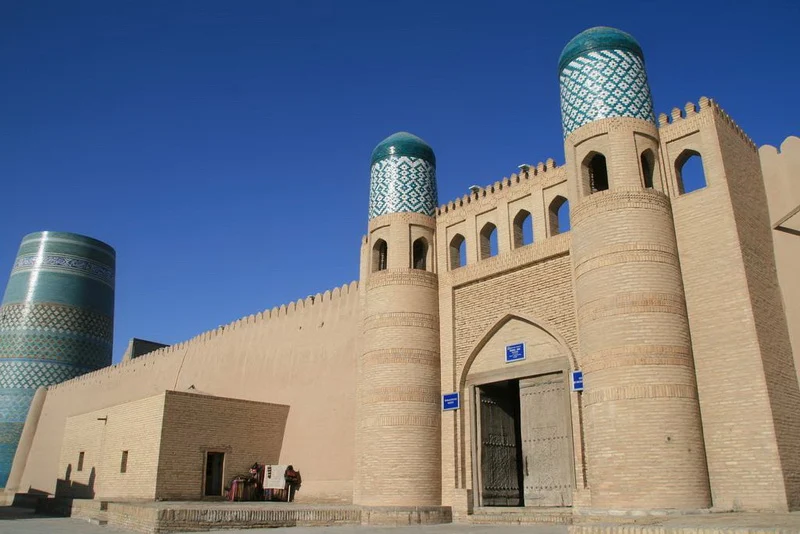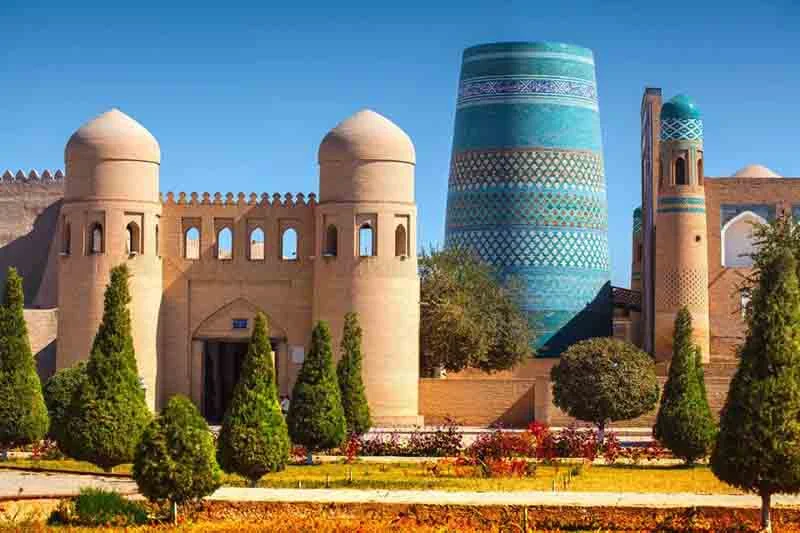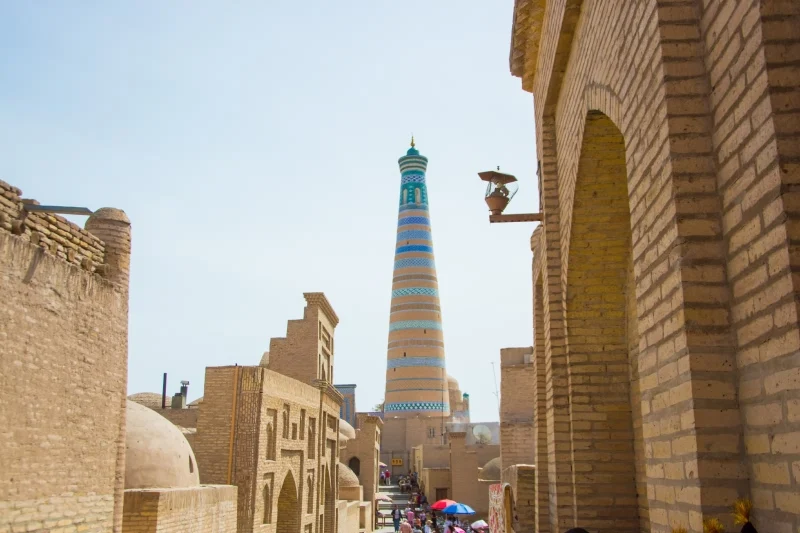It is believed that Khiva is 2500 years old. It is said that this oldest city in the world was founded by the Biblical Shem (Shoma) - the son of Noah. First described in Persian and Arabic sources in the 10th century AD, Khiva began to acquire its power and political influence from the 16th-18th centuries to become the capital of the powerful Khiva Khanate.
1. Kunya Ark
Translated from the Turkic languages, Kunya Ark means "old fortress" - citadel. The fortress served as the official residence for many generations of Khiva khans, until 1920 the khan lived in Kunya-Ark. The square in front of the central gate is the main square of the city; for many centuries, training camps and parades were held on this square, which the khan watched from the fortress wall. Behind the fortress wall in Kunya Ark there were: a reception hall, the khan's office, a winter and summer mosque , a mint and, of course, the famous khan's harem, as well as many ancillary rooms, from which during the excursion it is worth paying attention to the stables, the khan, as well as most of the rulers of the east, loved horses.
 |
| Kunya-Ark in Khiva, Khiva Landmarks |
2. Center of Khiva (Ichan Kala)
The Center of Khiva or Ichan Kala (inner city) is unique in that it gives the traveler a clear and complete picture of what the medieval Central Asian city looked like. That is why, back in 1984, Khiva was included in the UNESCO World Heritage List, long before Samarkand and Bukhara were included there.
Ichan Kala is a real tourist attraction of Khiva, only within the fenced area of the inner city you can see more than 60 architectural monuments: fortresses, locks, madrasahs, mosques, mausoleums, minarets, caravanserais and baths. The uniqueness of Khiva is that Ichan-Kala is not only a "city-museum", but also a place where more than 4000 local residents live, so that the real living spirit of Central Asia has been preserved here.
 |
| Center of Khiva, Khiva Landmarks |
3. Juma Mosque
The Juma Mosque in Khiva is one of the most unique mosques in Central Asia, famous primarily for its archaic architecture, it was built in 1788-1789 .. The area is 55 meters by 46 meters, the mosque is distinguished by its carved wooden gates, 213 carved wooden columns and a minaret 47 meters high. Approximately 25 pillars date from the 10th-16th centuries of which there are or seven of them belong to the original mosque of the 10th century, although the current building dates from the 18th century. Light enters the mosque only through two openings on the roof (skylights), which bring an atmosphere of mystery to the interior and also improve the acoustics of the premises.
From the inside, you can climb a dark and narrow staircase to the sun-drenched observation deck of the 47-meter minaret of the Juma Mosque, which offers a beautiful panoramic view of Khiva.
 |
Juma Mosque, Khiva Landmarks |
4. The Tash Khaouli Palace
Tash Khaouli literally means "stone courtyard", the main palace was built by Allakuli-khan of the Kungrad dynasty - the only Khiva khan who did not like to live in Kunya Ark. It is interesting that the first was the harem, and only then the mekhmonkhona - a place for official receptions and the last - the arzkhona, the courtroom. Khan's ambitions led to the unique design of the Tash-Khauli palace, which surpasses the old palace in the degree of variety of patterns - majolica, wood and marble carving, as well as painted ornaments.
Two separate entrances lead to two separate wings of the palace. A handicraft exhibition is located in the northern harem. There is a throne room in the south wing .
 |
| Tash Khaouli Palace, Khiva Landmarks |
5. The Pakhlavan Mahmud Mausoleum
A magnificent turquoise dome crowns the Mausoleum built on the grave of a Sufi, poet, invincible fighter and patron of Khiva - Pakhlavan Makhmud. The interior walls, ceiling and tombstone have continuous blue majolica tiles. The sacred well in the courtyard is said to contain water for healing qualities, and a bucket from the well is believed to provide a happy future for dozens of newlyweds. The mausoleum is a popular Muslim pilgrimage site.
 |
| Pakhlavan Mahmud Mausoleum |
6. Kalta-Minor Minaret
Kalta-Minor means "short minaret" in Turkic. It is only 26 meters high, but its base is 14 meters in diameter. If it were built to its full height, it would surpass all known minarets in the Muslim world and would be 75 meters high! Alas, the construction of the minaret was stopped after the death of the initiator of the construction, Muhammad Amin Khan, who died in a battle near Serakhs. This minaret is the only one in all of Central Asia that is completely covered with enamel bricks and majolica.
 |
Kalta-Minor Minaret, Khiva Landmarks |
7. The Islam Khoja Minaret
It is considered one of the main attractions of Khiva. In its conical shape, the 45-meter high minaret resembles the Kutlug-Timur minaret in Kunya-Urgench (Turkmenistan). Towering over the surrounding quarters, the minaret is visible from any part of the city. It served as a kind of beacon for caravans.
8. Lake Shorkul
30 kilometers from Khiva, in the sands of the Karakum Desert, there is a real natural attraction of Uzbekistan, Lake Shorkul. Lovers of active recreation can take a walk or swim in it. The lake is home to thousands of birds, including pelicans, cormorants, ducks and swans.
 |
| Lake Shorkul, Khiva Landmarks |
